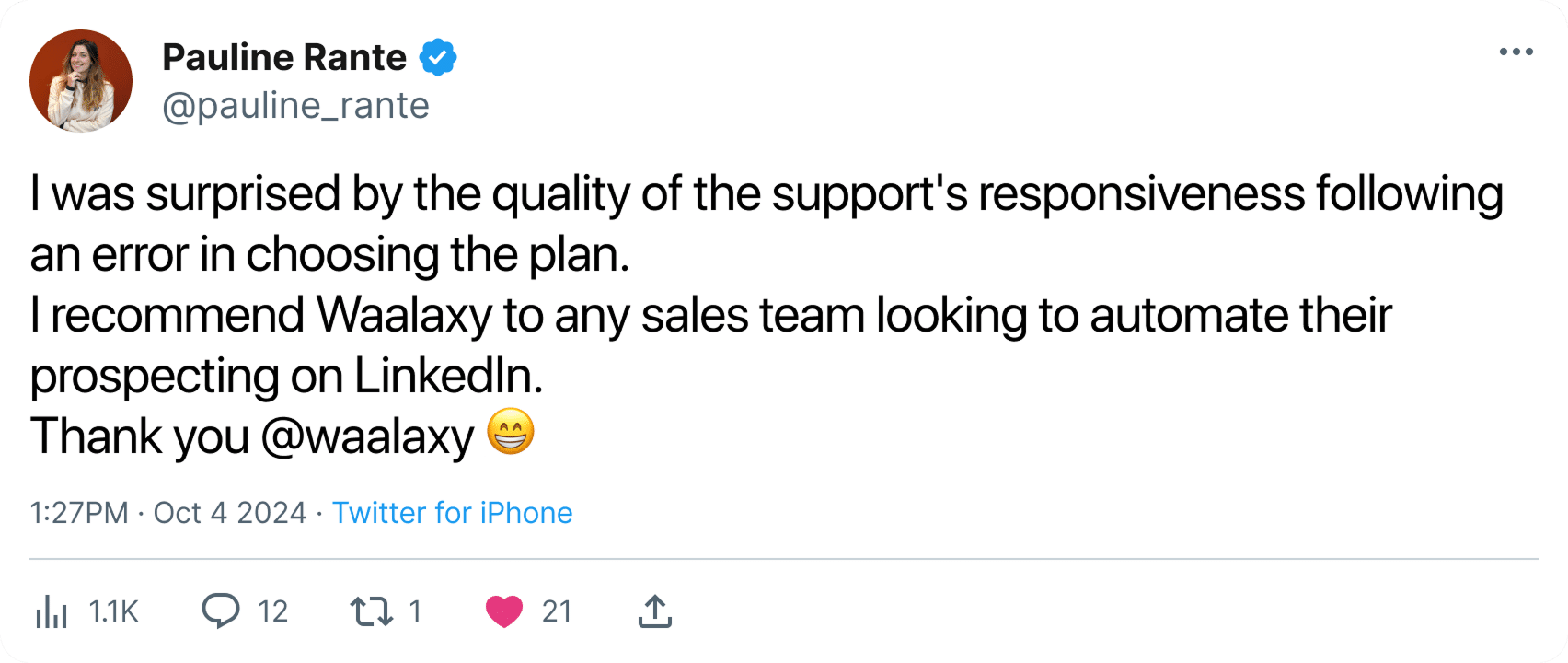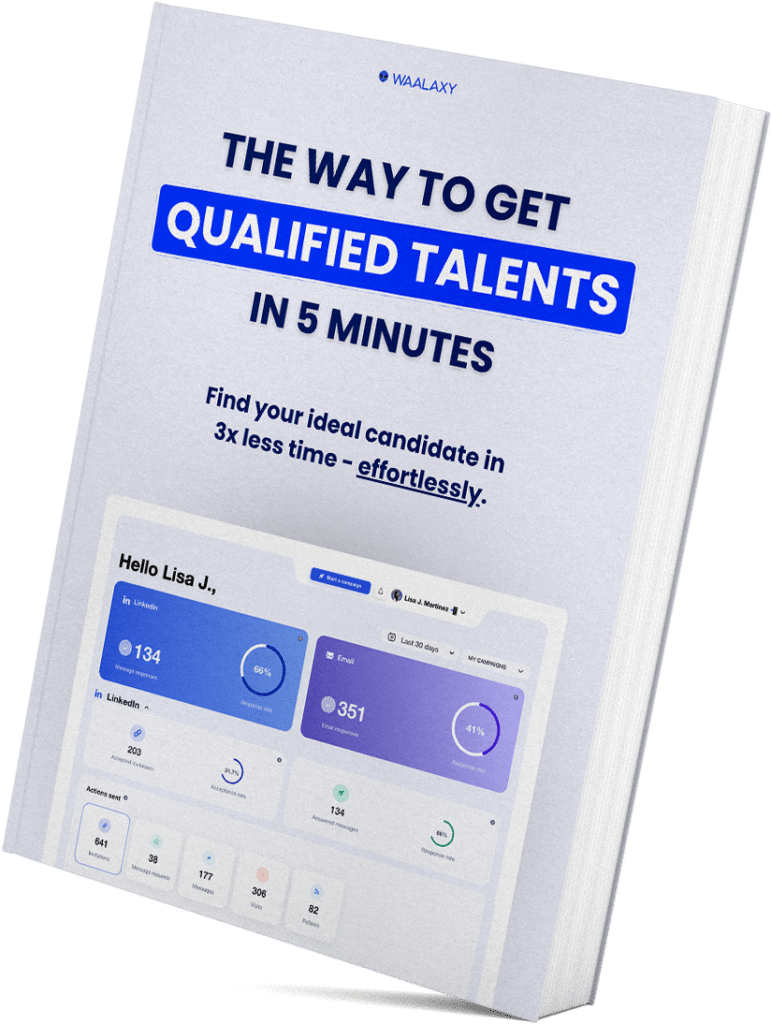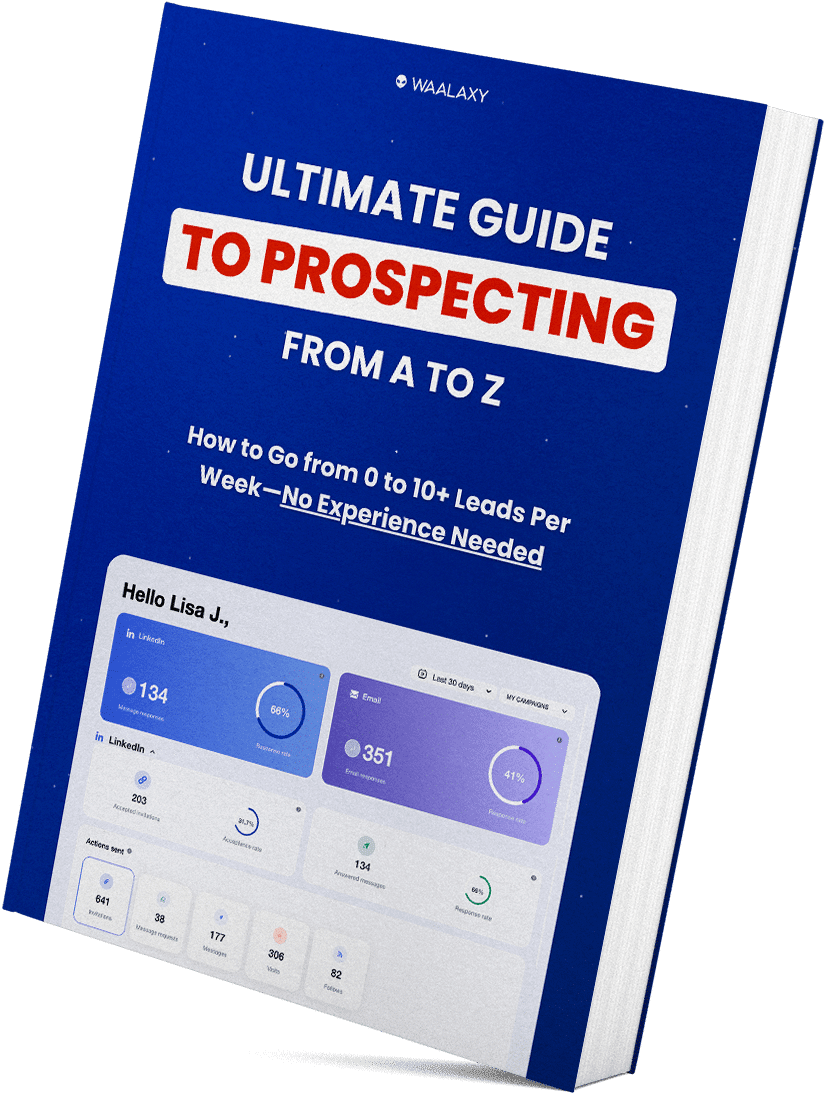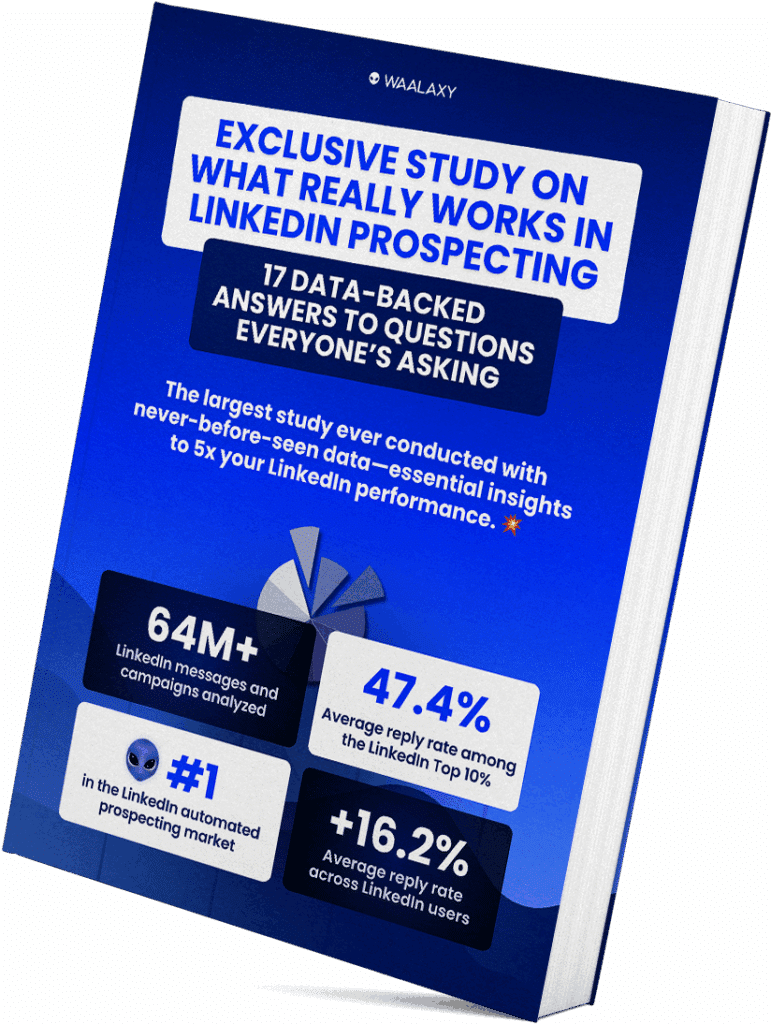- What is a snackable content?
- Why integrate snackable content in marketing strategy?
- The cognitive biases behind snackable content
- 5 snackable content examples to try out
- How to create snackable content?
- How can snack content be integrated into a global strategy?
- Shall we have a recap?
- Frequently asked questions
You scroll through your LinkedIn feed, and hop ✨ a 30-second video catches your eye. You like, comment, maybe even click. Voilà: you’ve just consumed snackable content.
In digital marketing, this format has become a must. Why? Because we live in an info-saturated world 🌀 where every second counts. And above all because your prospects, whether B2B or B2C, are constantly on their mobiles.
In this article, you’ll discover what snack content really is, why it works so well and how to use it concretely to boost your marketing strategy and generate more leads 🚀.
What is a snackable content?
Snackable content is short, punchy content that’s easy to consume and designed to grab attention in a matter of seconds. A LinkedIn post, a 60-second video, a well-thought-out micro-infographic… The principle is simple: seduce quickly, stay in your memory and make you want to go further. ✨
Above all, this format responds to a real challenge: users are drowning in info. Between newsletters, posts, videos, ads… their attention has become a scarce resource ⏳. Snack content has emerged as an effective solution: concise, punchy and perfectly suited to the constant scrolling of mobile uses 📱. The result? You multiply your chances of being seen, understood and retained.
Snackable content a B2B or B2C format?
We often associate this format with B2C brands (TikTok, Instagram, Reels…). Yet in B2B, snackable content has become a strategic asset. Why? Because LinkedIn is saturated with long, sometimes overly technical posts. A short, clear, visual format immediately stands out from the crowd.
👉 A simple carousel summarizing a study or a 30-second LinkedIn video teasing an ebook: it’s quick to consume, but opens the door to your premium content.
Why integrate snackable content in marketing strategy?
Snack content isn’t just “about making” look good or filling your editorial calendar. Behind its apparent simplicity, it has three main objectives. 👇🏻
1. Engage followers
A good snackable content triggers an immediate reaction: a like, a comment, a share. In short, it awakens your prospects from their passivity.
➡️ Why it’s key:
- 👀 Engagement sends a positive signal to Linkedin algorithms, your content is deemed relevant, so shown to more people.
- 🥰 The more interaction your content generates, the stronger the link you create with your audience.
- ☎️ A prospect who comments or shares becomes more memorable and therefore easier to get back in touch with.
2. Be visible to your prospects
News feeds are saturated. Your prospects are scrolling at breakneck speed, stopping only at what catches their eye in a matter of seconds. In this context, visibility is a real battle ⚔️.
Snack content has a natural advantage: it breaks the scroll barrier. Social platforms like LinkedIn, Instagram or TikTok favor it in their algorithms. And it fits in perfectly with mobile usage 📱 where the majority of content is now consumed. By regularly publishing small, clear and quick formats, you multiply the opportunities to appear in your prospects’ feed… without tiring them out.
Aim for regularity rather than perfection. An “imperfect” snack content published today has more impact than a perfect “post” postponed indefinitely. Your visibility is built with frequency and consistency 🔄.
3. Generate leads
You might think that snackable content is just for quick entertainment or information… but in reality, it’s also a powerful lead generator. Think of it as a hook: it attracts attention, then redirects your prospects to richer content, where conversion takes place.
- 📚 A short post can make you want to download a white paper.
- 📹 An express video can tease a webinar.
- 📝 A micro-infographic can encourage people to consult a complete study.
In practice, then, snack content acts as a gateway: it captures your audiences with a light format, then subtly steers them towards a more engaging action 🕺🏻.
The cognitive biases behind snackable content
It’s no accident that snack content works so well. In fact, it exploits several cognitive biases that influence the way we consume information. In marketing, understanding these biases means being one step ahead 🧠.
The salience effect
The brain loves what stands out. In a LinkedIn feed full of similar posts, what’s visually distinct immediately catches the eye. A strong contrast, a shocking phrase, a huge number… and boom 💥, you’ve captured attention.
Dare to use minimalist yet striking visuals. No overloaded design. A strong color plus key data and you’ve already got a snack that works.
For example: Publish a visual with in large type: “87% of leads are never followed up”. No need for long text, this stat is enough to pique curiosity and trigger a click.👀
Novelty bias
We’re programmed to pay more attention to what’s new. That’s why an original format or offbeat tone stands out on very “corporate” networks like LinkedIn. 😌
You can test a format that your audience doesn’t expect you to publish. It could be a short reel, a humorous carousel or even a micro-video “backstage”. The novelty creates an eye-catching contrast.⚓️
The scarcity effect
Urgency spurs action. When an opportunity seems limited in time or quantity, your prospect reacts much more quickly. Snack content, because of its brevity, is perfect for getting this kind of message across. It gives an even stronger impression of urgency 💌
For example: a 15-second LinkedIn video announces a webinar: “100 places only – registrations open today”. The information is clear, direct with a CTA that pushes the audience to click.
The simplicity effect
The more complex the content, the more attention you lose. Snack content capitalizes on this logic by getting straight to the point: one message per piece of content 🥹
Reread your snacks with this question in mind: “If I had to summarize in one point, what would it be?”. If you come up with several ideas, break them up into several snacks rather than mixing everything together. 😏
Snackable content isn’t just “short”. It’s designed to speak the language of the brain, exploiting those cognitive biases. That’s why a 3-line post or a micro-video can generate more impact than a 1,500-word article.
5 snackable content examples to try out
How can you apply it to your marketing strategies? You don’t need to be a creative agency with a team of 15 people. Snack formats are accessible, quick to produce, and above all effective if you adapt them to your audience.
On LinkedIn (and more broadly in B2B), certain types of content work particularly well. Here are 5 examples of snackable content you can try out tomorrow to boost your visibility and generate more engagement.👇
1. Short posts
A few lines are sometimes enough to generate a maximum number of reactions. On LinkedIn, short posts have the advantage of being visible without additional clicks. 👀
This format is ideal for 👇🏻 :
- Sharing a hard-hitting statistic.
- Launch a thought, a quote, a debate.
- Ask your network a direct question.

2. Snack content videos (LinkedIn natives, Shorts, Reels)
The brain processes a moving image much faster than text. As a result, short videos attract and hold attention more easily than a paragraph.
In B2B, a snackable content video is perfect for 👇🏻 :
- Teaser an event or special offer.
- Explain a complex concept in a few seconds.
- Give a quick overview of a customer case or success story.
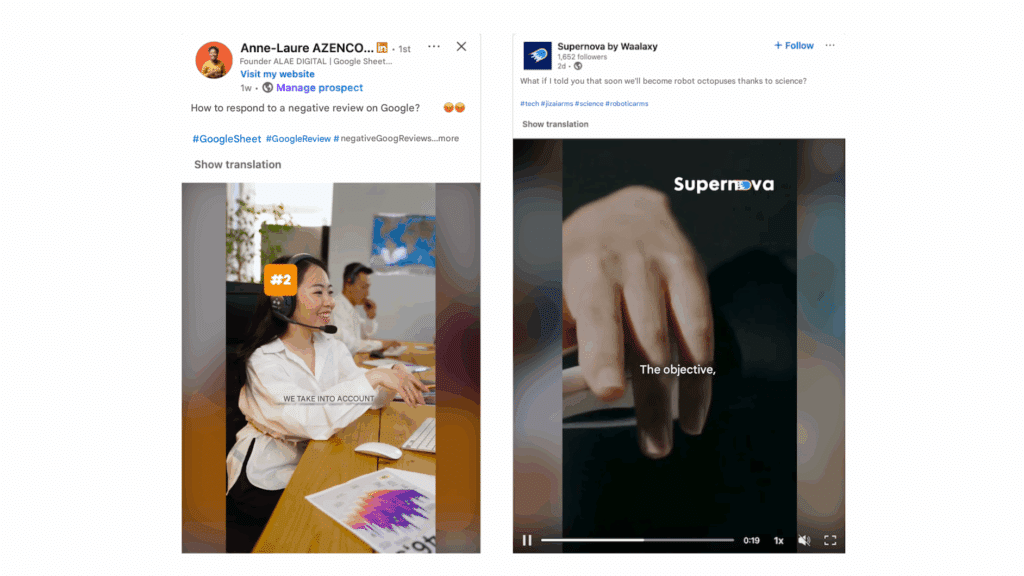
Structure your videos in 3 steps with a strong hook from the first second, a main idea developed quickly, and a final CTA that directs the audience (register, download, get in touch).
3. Memes and GIFs
Humor is an underestimated weapon in B2B. Yet a well-crafted meme or well-chosen GIF can break LinkedIn’s overly serious tone. You show that your brand knows how to speak “real” and connect with its audience.🤓
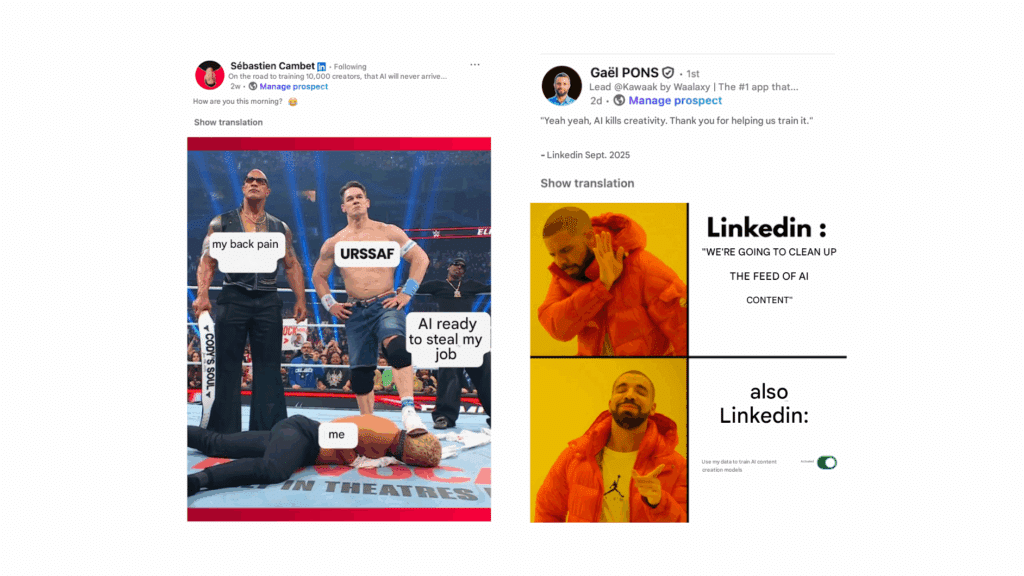
A good B2B meme is used to illustrate a situation that your prospects are familiar with and then to make fun of a difficulty in everyday business life 💼
4. Micro-infographics
When you want to convey a key idea quickly, nothing beats a clear, synthetic visual. Unlike large infographics, micro-infographics focus attention on a statistic, a tip or a mini-process🥹
This format is effective for 👇🏻 :
- Simplifying complex data.
- Summarizing an article or report.
- Emphasize a step-by-step method.
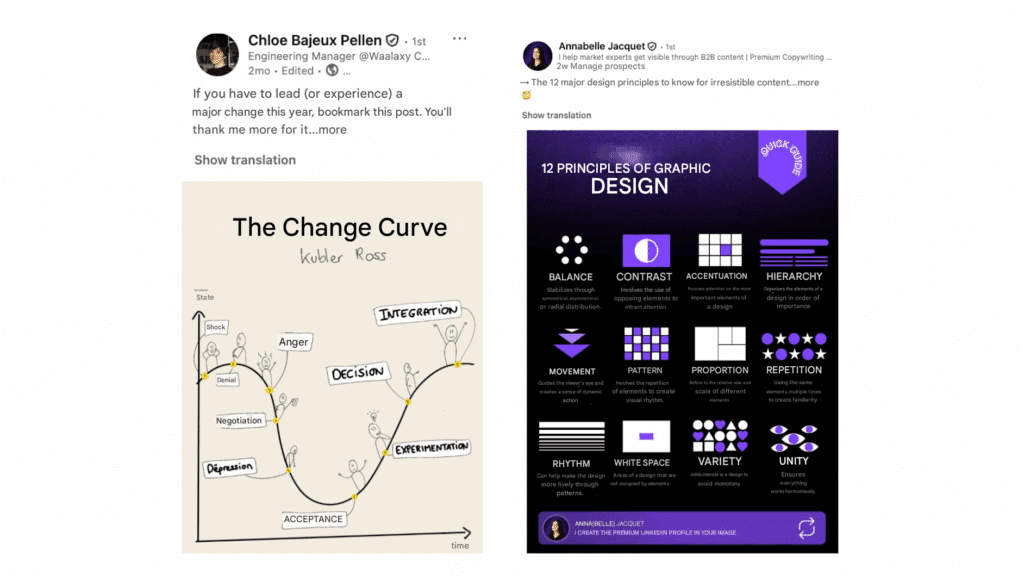
5. Stories, polls and interactive formats
What if your prospects became actors in your content? Interactive formats like polls and quizzes are perfect for stimulating participation. With just one click, your readers express their opinions, and you reap valuable insights. 😎
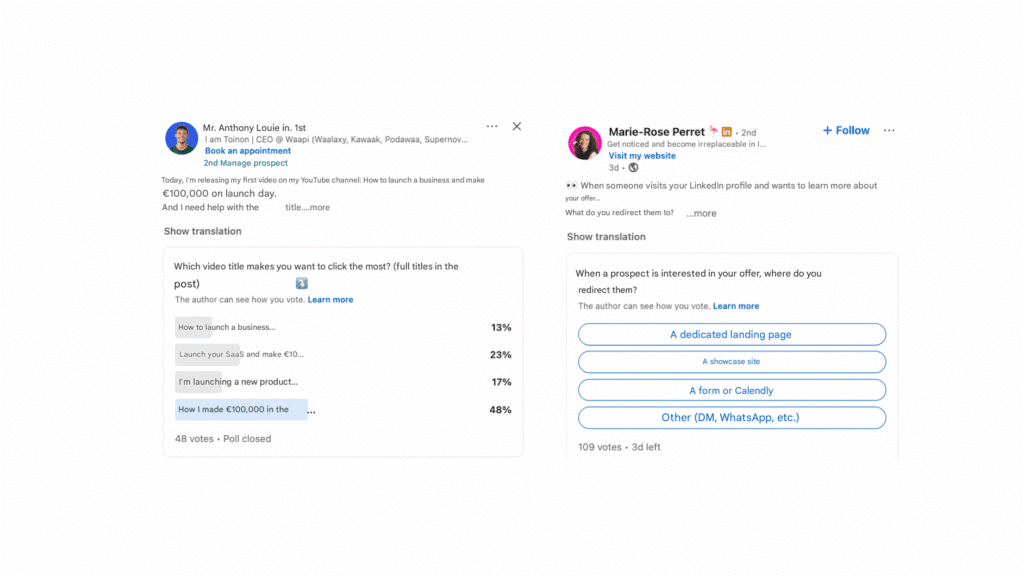
➡️ This type of content allows you to :
- Ask a quick question and get feedback.
- Test ideas or validate hypotheses.
- Launch a discussion on a key topic.
No more than 3 answer choices for a survey, short questions and sharing the results with your analysis. 📈
How to create snackable content?
Snacking content may seem simple: a short post, a 20-second video and off you go. But in reality, to make a real impact, you need a minimum of method 🎯.
The aim isn’t to churn out quick-fix content, but to create short formats that serve your marketing strategy.🫠
Step 1: Get inspired by trends
Snack content keeps pace with current events and marketing trends. A circulating meme, a buzz stat, a hot story in your sector… anything can become a snackable hook 😎
The idea isn’t to copy and paste what you see elsewhere, but to reinterpret it with your brand’s voice. That’s how you stay relevant, without falling into generic content.
Set up a weekly mini-watch. Follow the key hashtags in your sector, observe your competitors and note what attracts the most interactions. This becomes your raw material for creating snack content.🍟
Step 2: Choose the right format for the right platform
The same content doesn’t work everywhere. What explodes on TikTok can be a total flop on LinkedIn. 🥲
Every platform has its own codes, and snackable content is there to exploit them. However, you can have a central idea and decline it. One message but several different snack contents 🤓
- 💼 On LinkedIn: short posts, simple carousels and 30-60 second native videos.
- 🎨 On TikTok/Reels: Dynamic vertical videos, with a visual hook from the first second.
- 🤩 On Instagram: interactive Stories, visual quotes, educational micro-carrousels.
Step 3: Define your message
Many marketers think that snack content = quick, no-fuss content. As a result, you end up with empty posts or videos that don’t add anything 😒
Good snackable content starts with a clear message. Before you get started, ask yourself this simple question:
“What unique idea do I want my audience to remember?”
It could be a statistic, a practical tip, or an inspiring mini-story. But it should always be one idea at a time. That’s what will make your snack memorable, not just another piece of content that gets lost in the feed.🕺🏻
Once this message has been defined, focus on the quality of execution. Short doesn’t mean sloppy. Even in three lines or 20 seconds, you can tell a compelling story 👇🏻 :
- A LinkedIn catchphrase that grabs attention immediately.👀
- An ultra-synthetic development.📝
- A conclusion or CTA that makes you want to go further.🌍
Step 4: Use the right tools
You don’t need an army of graphic designers or a video studio to create effective snack content. Today, there are simple, fast and accessible tools for producing professional formats in no time. Here’s a mini-toolbox to keep handy. 👇
| Tool | What is it for? | Why is it useful for snackable content? |
|---|---|---|
| Canva 🎨 | Create visuals, carousels, micro-infographics. | Hundreds of ready-made “snackable” templates, perfect for saving time and keeping a consistent visual charter. |
| CapCut 🎬 | Edit short videos, add subtitles and effects. | Ultra handy for mobile-friendly LinkedIn, Reels or Shorts videos. |
| Notion 📒 | Centralize your ideas, organize your posts, plan. | You create a real library of snacks, avoid the draft and structure your editorial planning. |
How can snack content be integrated into a global strategy?
Snack content isn’t a separate strategy, it’s a piece of the puzzle 🧩. Taken in isolation, it creates quick engagement… but it’s by integrating it into your overall strategy (SEO, inbound marketing, social media) that it becomes useful.
Recycling your long-form content into snackable content
An ebook, blog post or webinar doesn’t have to live solely in its original format. Long-form content can be broken down into several snacks:
- A key figure: a LinkedIn post,
- A powerful idea: A micro-infographic,
- A striking passage : A short video or a quote.
Snacks attract, long-form content converts. But be careful where you draw the line: a snack should make you want to go further, not reveal everything. Always keep a little material to entice your prospects to click.
You need to strike a balance between slow and snack content. 😌
Snacks are your gateways, your “quick hooks”. Long-form content (articles, white papers, case studies) builds your credibility over time. ⏳
Here’s a little comparison chart: 👇
| Format | Main lens | Consumption time | Role in strategy |
|---|---|---|---|
| Snack content | Attract, engage, trigger initial interaction. | A few seconds to 1 min. | Generate visibility and open the door. |
| Long content | Provide in-depth information, convince, convert. | 5 to 30 min | Reinforce expertise and inspire action. |
Turn attention into leads
A like, a comment or a share is great… but it doesn’t pay the bills. What you’re looking for is to turn that little spark of attention into a concrete business opportunity. And that’s where snack content comes into its own. 💎
A successful short post on LinkedIn is, in effect, a database of potential leads. Every person who interacts sends you a signal of interest, however weak. Rather than letting that interaction go unheeded, you can turn it into action with tools like Waalaxy. ✨
👉 How does it work?
- 🙆🏻♀️ You identify the profiles that have interacted with your content (like, comment, share).
- 📩 You import the leads who liked or commented on your post directly into Waalaxy.
- 📨 Launch a personalized message campaign. The idea is not to sell direct, but to send a tailored message: launch a discussion on a post ,a stat that resonates with their profile, a micro-study, a mini-customer case…
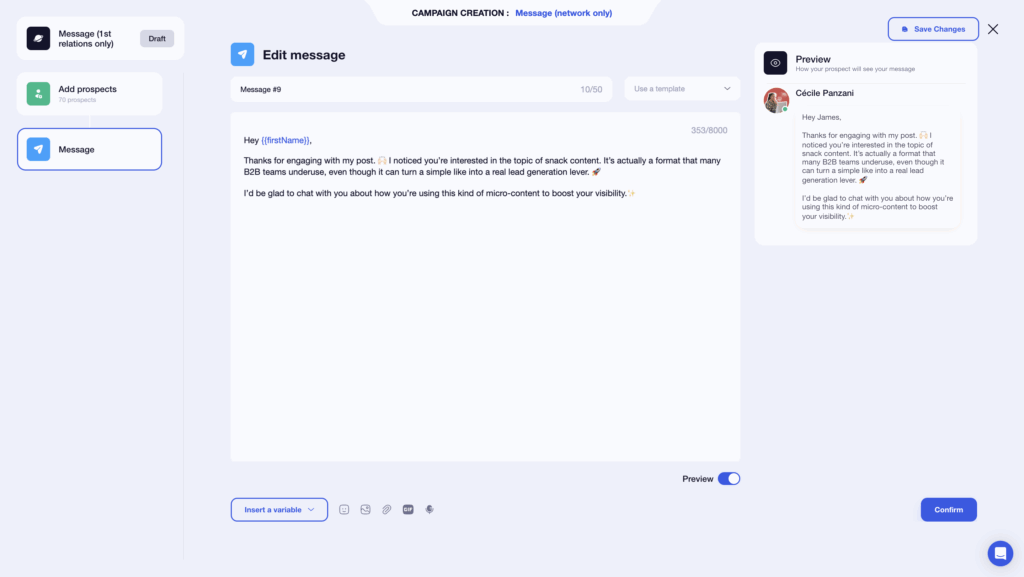
So your snacks don’t just sit in the feed, they become “hooks” that feed your prospects. And you create a much more qualified relationship than with classic outbound marketing. 🧲
Shall we have a recap?
Snack content is the art of capturing attention in a matter of seconds ✨. Short, punchy, and mobile-first, it delivers easily digestible, bite-sized content perfectly adapted to today’s shrinking attention span. It attracts your leads, sparks engagement, and opens the door to your longer content. And with tools like Waalaxy, every snippet can be repurposed, shared, and turned into a real business opportunity 💰.
Snacks attract, long-form content converts. It’s up to you to find the right balance, create shareable experiences, and boost your marketing strategy 🥰.
Frequently asked questions
Is it necessary to have a brand content strategy before launching a snack business?
Yes, absolutely. Snack content only makes sense if it’s part of a solid brand content strategy and fits into your broader content marketing plan. 🎯
Before producing short-form posts or express videos, you need to be clear about your brand messages, tone, and objectives. Otherwise, you risk creating snacks disconnected from your identity. 🫠
Think of the snack as a shop window: it attracts quickly, but it must reflect the consistency and values of your brand. And once created, a good snack can also be repurposed into other formats to maximize impact. 😌
What are the trends to watch for snack content?
The format is evolving fast, and several trends deserve your attention: 👇
- Creative AI: Tools like ChatGPT, Runway or Opus Clip are already helping to generate scripts, cut videos or create “snackable” visuals in a matter of minutes.
- The return of LinkedIn stories: They could well return in a different form, and we’ll need to be prepared for that.
- Snackable social audio : Short audio formats (mini-podcasts, conference excerpts) are beginning to emerge.
- Customer micro-cases: In B2B, sharing a success story in 20 seconds or 3 slides is becoming the norm.
Snack content will continue to be perfected. The brands that succeed will be those that quickly test new formats… without losing sight of their overall strategy.🌍
Now you know all about snackable content!


